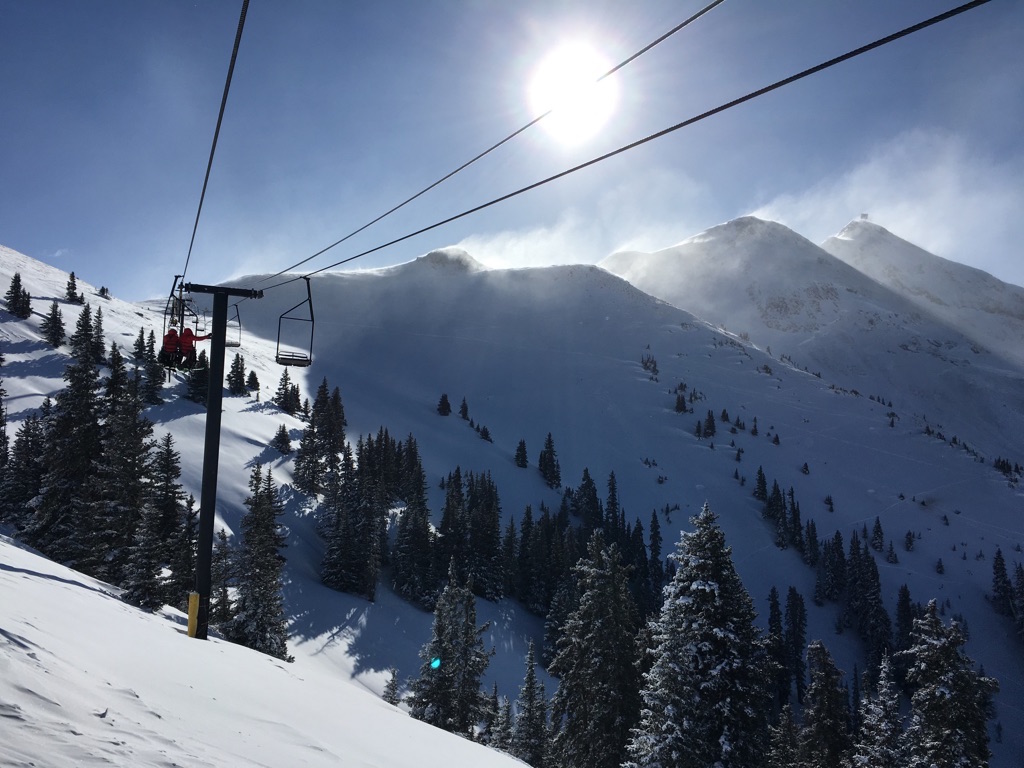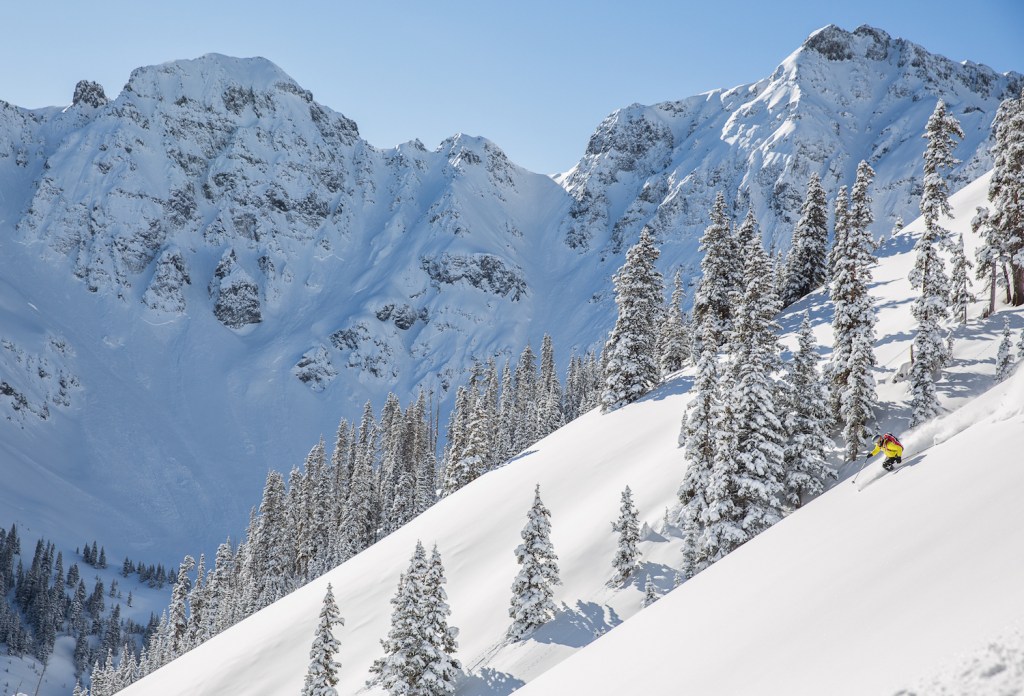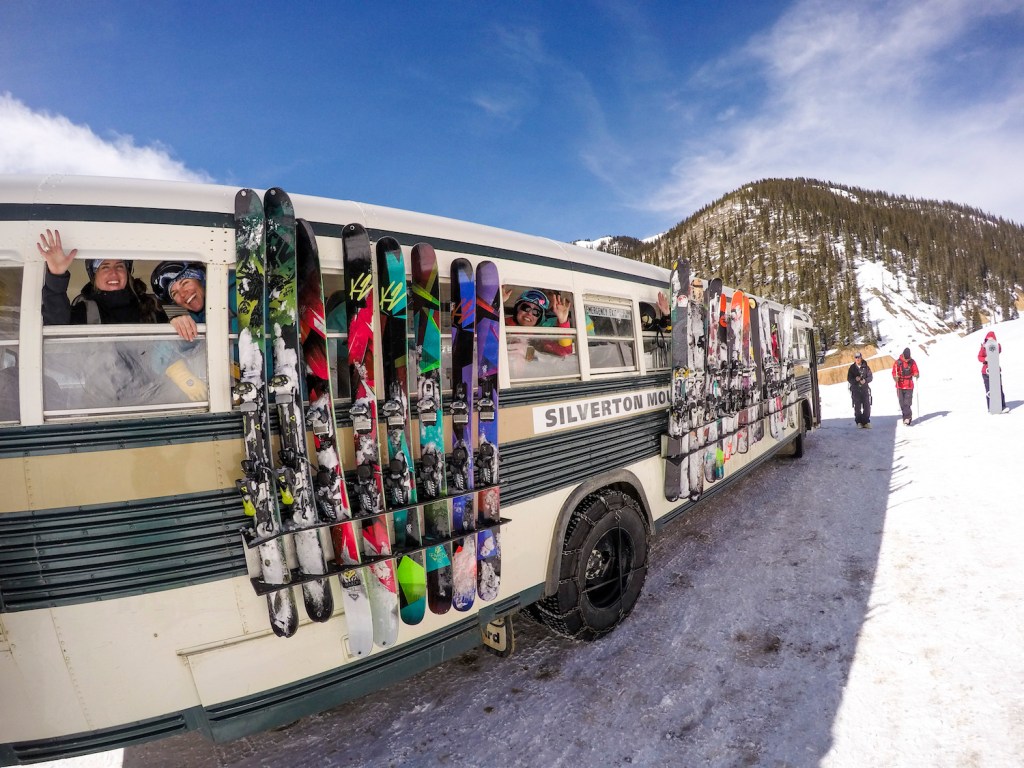In early October, ski patrollers at Colorado’s rugged Silverton Mountain were already making powder turns. By November, the mountain had seen 246 percent of average snowfall at that time of year, so they fired up the bird for heli-skiing on November 24, weeks ahead of schedule. The ski area’s lone double chairlift is slated to start turning December 27, but they say that date could bump up, too. The truth is, at this wild, throwback ski hill, you never really know what to expect.
It would be a stretch to call Silverton a resort. You get there by driving up a winding, old mining road. There is no fancy lodge, base-area restaurant or ski school. Near the dirt parking lot, you’ll find a simple canvas yurt, where you can demo powder skis, rent avalanche safety gear and get a beer after skiing. The bathrooms are porta-potties; the locker room is your car.

Silverton Mountain has one double chairlift that carries riders to 12,300 feet.
Go time is 8:20am for your avalanche safety briefing, where you and around 80 other riders (they cap the number of skiers on the hill each day) will be broken up into small guided groups—another sign this isn’t your average mountain. For most of the peak season, you are required to ski and ride with a guide.
The one double chairlift clunks riders up to 12,300 feet, and from there you can hike all the way up to 13,487 feet. You can access 1,819 acres right off the lift, with up to 22,000 acres reachable by hiking or helicopter. The terrain drops down two sides of a knife-edged ridge: chutes and tight trees on the west face, open bowls with names like Mandatory Air to the east. There is no snowmaking, no grooming and no easy way down. A dispatcher sends guided groups out in different directions, so when conditions are good, you’ll almost always be skiing untouched snow.
A mid-season lift ticket at Silverton, which comes with a guide, is $179, and you can get a single helicopter drop for the same price. That’s actually cheaper than the walk-up ticket price at some of Colorado’s ritzier ski resorts, and that unadulterated ski experience—frill free, but full of the kind of untracked turns that people pay a lot of money for—is why Silverton started in the first place.

You won’t come here for sushi joints and wine bars. It’s all about the skiing.
In 2002, Silverton became the first new ski area in Colorado since the early ’80s. Owners Aaron and Jen Brill were ahead of the hike-to, backcountry-focused trend in skiing. They’d traveled around the world, skiing and snowboarding, and they liked the small ski areas they visited in places like New Zealand. They decided to create a similar ski mountain in the States: a simple, rustic place focused on serious skiing, not on après bars, slopeside condos and manicured groomers.
“We had a dream of a ski area with one surface lift and a gate to raw, uncontrolled backcountry terrain,” Jen Brill said. “We never envisioned that Silverton Mountain would have such high level of success and bring people in from around the globe.”
They had a vision for the kind of ski hill they wanted, but it took them a long time to settle on Silverton, a remote Colorado mining town at an elevation of 9,318 feet. Aaron says he had only skied a single day in Colorado before finding the mountain. They’d been looking in Idaho and Montana for the perfect spot, but the steep, snowy pocket of the San Juans sucked them in.

Ski down the back bowls and an old school bus will transport you to the lift.
They found the location, but then they had to convince other people to see their vision. It took years to sort out the logistics, from insurance to permits to investment dollars. They trucked a hand-me-down chairlift from California’s Mammoth Mountain out to Silverton, then dug the holes for the lift towers by hand. Even once they had the ski hill operating, they still had to convince people to come visit a wild mountain, up a narrow road from an already-hard-to-access town.
But, more than 16 years later, Silverton has become an iconic institution for hardy skiers and riders, a proving ground for anyone who calls themselves a skier. The mountain has hosted snowboarder Shaun White’s private halfpipe and big mountain skiing events like the Red Bull Cold Rush. Pro skier Chris Davenport, who often visits from Aspen, calls it the most pure ski experience you can find today. “It’s like heli skiing with a chairlift,” Davenport said.
If you like that purity, the quirks are part of the thrill. When you end up back at the road, after skiing, say, the steep gullies of Vodka Shots or the bowl of Chaser Face, you’ll get picked up by a lumbering old school bus slicked with stickers on the inside. You can buy a sack lunch, and after skiing, the yurt turns into a bar. So does the deck, if the weather is right. You can camp on the road, as long as you move your vehicle for snow removal.
So put Silverton Mountain on your must-visit list—and this winter might be the time to go. Because when you drop off that high-altitude ridge into sustained, snow-choked glades with your guide whooping behind you, you’ll realize there are few places, especially in the United States, where you can make turns like that.
Travel Tips
Stay: The Triangle Motel is your best budget option. If you want to go upscale, the renovated Wyman, which should be completed in January, is shaping up to be beautiful.
Eat and Drink: Options are limited, but they’re good. Hit the Coffee Bear for breakfast on the way up the hill, and finish your day at the Avalanche Brewing Company for Thai pie pizza and a Sultan IPA.
When to Go: Heli drops are available now and the guided season runs from December 27 to March 17. Unguided season is March 21 to April 14. During the unguided season, where you can ski wherever you want within the boundaries, you can still hire a guide to take you into the out-of-bounds areas.
Get There: The Durango and Montrose airports are each about an hour away over a serious mountain pass. Denver is around a six-hour drive.
